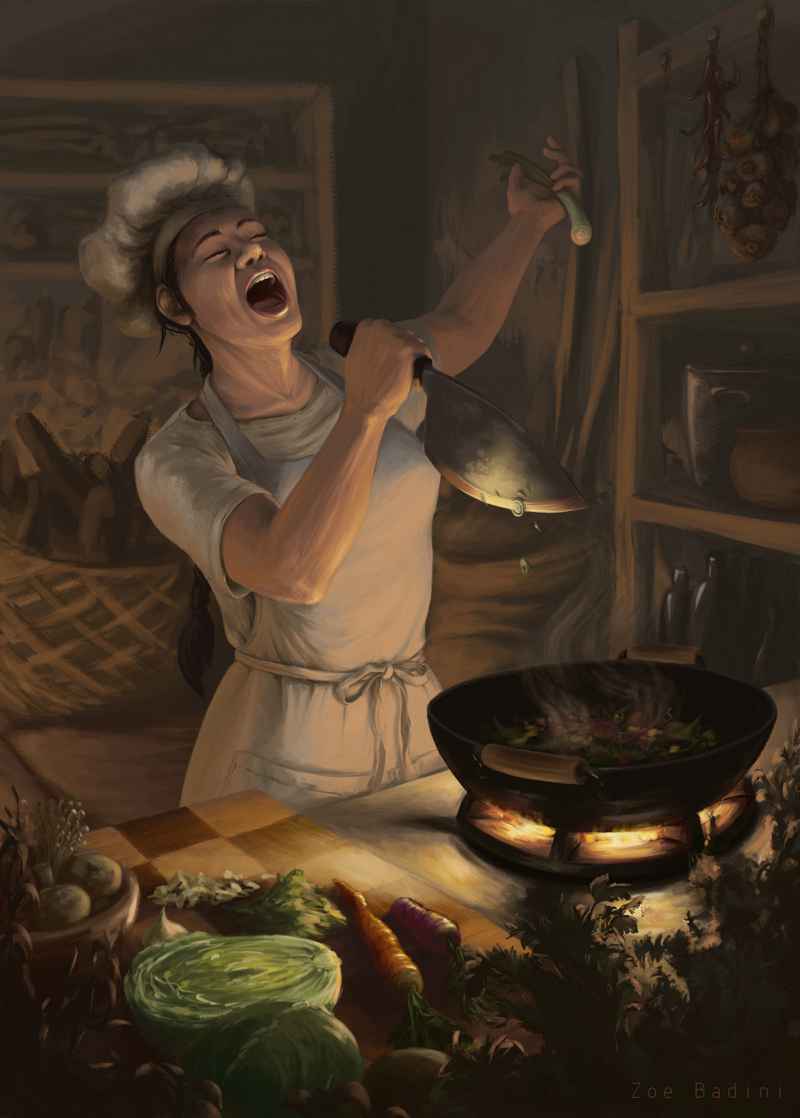Galley Kitchen
Galley kitchens are compact and highly efficient food preparation areas, designed to maximise limited space while still allowing for effective cooking and storage. A narrow aisle, flanked by cabinets, shelves and work surfaces, allows for a streamlined workflow, ensuring that essential ingredients, tools and cooking surfaces are always within reach. The firebox, constructed from stone or brick, is raised for ease of use and its flue or chimney allows smoke and heat to be directed outside, maintaining a functional and safe environment.
Contents
In some instances, galleys lack a built-in firebox, instead relying on campfires for cooking. This is most common in mobile kitchens, such as cookwagons, which are designed to support traveling expeditions, military campaigns or itinerant traders. A cookwagon features fold-down shelves, which expand the available workspace when parked but lock into place for travel. Cabinets and storage bins are often attached to the wagon's exterior, making use of every possible inch of space. A large vardo built specifically for cooking often incorporates both an enclosed galley inside and external storage elements, blending the advantages of stationary and mobile kitchens.
Aboard ships, the galley kitchen is referred to as a camboose, a term later shortened in English to "caboose". The firebox aboard a ship is uniquely designed to be safely extinguished in case of battle or storm, with a hinged door on the hull exterior, allowing the burning coals to be swept overboard. This feature prevents ship fires and ensures that cooking can continue safely even in challenging maritime conditions.
Food Choices
The galley kitchen allows for the preparation of more refined meals compared to campfire cooking or cold camp fare. With its enclosed and organised workspace, it can produce simple but superior foods, including breads, soups, marinated meats and sauces that can be safely stored in crockery jars. This eliminates the risk of spillage or breakage when traveling, making it an ideal choice for long journeys. The presence of storage cabinets enables the preservation of fresh foods — such as leafy vegetables, fruits, meats, milk and cream — for 2 to 12 days, depending on conditions.
Herbs and spices, essential for flavouring meals, can be stored in hanging bundles or small jars, ensuring easy access for the cook. Commonly kept herbs include basil, chamomile, cumin, dill, rosemary, parsley and sage, along with dried tea leaves and roasted coffee beans. This variety enhances both taste and nutrition, elevating meals beyond basic sustenance.
Construction
As a galley kitchen requires metal fittings, brick, stone and specialised craftsmanship, it is more expensive per square foot than most other rooms in a house. Its construction must be customised to fit the available space and materials, making standardised pricing impossible. Traditionally, a single cook can operate within a 6-by-8-foot space, though most prefer larger layouts — with 8-by-10 or 8-by-12 feet offering greater comfort and efficiency.
The size of the firebox is a crucial factor in determining cooking capacity. A small firebox may only accommodate a single cook, limiting meal production, while larger fireboxes allow for multiple pots and pans to be used simultaneously, supporting higher food output. As a result, galley kitchens are not just about compact efficiency but also about balancing space, cost and cooking needs, whether on land, in a wagon or aboard a ship.
See The Adventure
